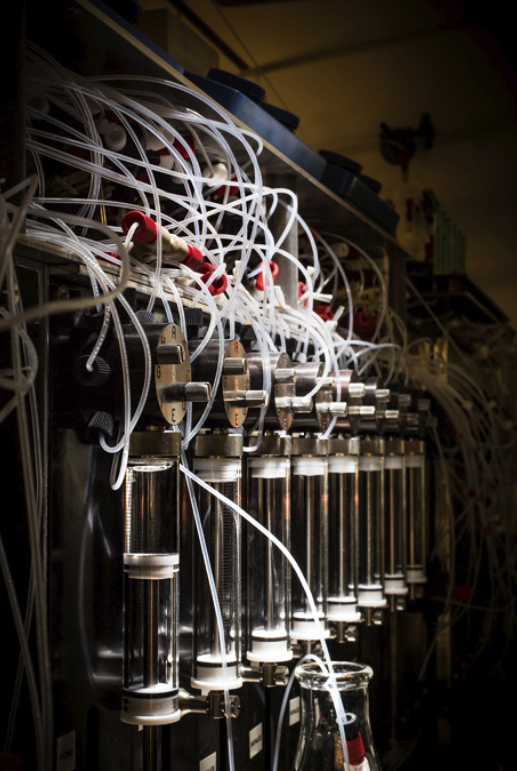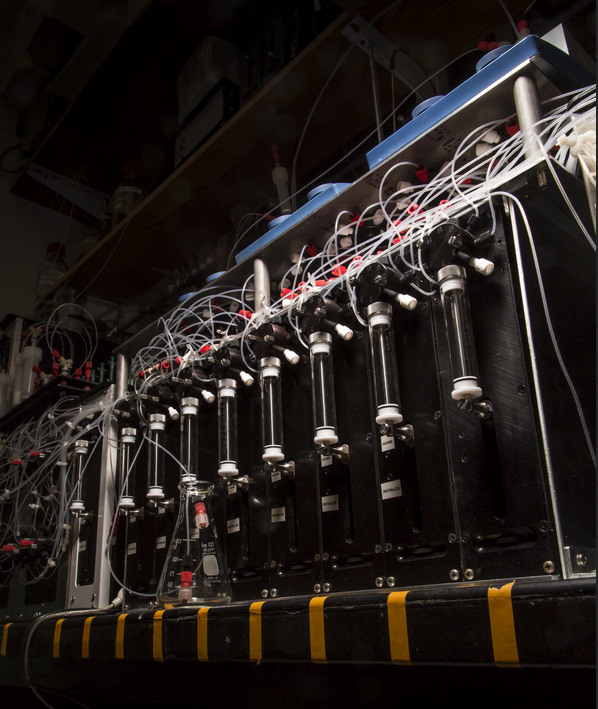What will 3D printers ultimately evolve into? No one has a functioning crystal ball in front of them I assume, but a good guess would be a machine which can practically build anything its user desire, all on the molecular, and eventually atomic levels. Sure we are likely multiple decades away from widespread molecular manufacturing, but a group of chemists led by medical doctor Martin D. Burke at the University of Illinois may have already taken a major step in that direction.
Burke, who joined the Department of Chemistry at the university in 2005, heads up Burke Laboratories where he studies and synthesizes small molecules with protein-like structures. For those of you who are not chemists, small molecules are organic compounds with very low molecular weight of less than 900 daltons. They usually help regulate biological processes and make up most of the drugs we put into our bodies, along with pesticides used by farmers and electronic components like LEDs and solar cells.
Burke and his team have created a machine which could be described as a major breakthrough in the field of chemistry, a ‘molecule-making machine’. Sound futuristic? Well that’s because it is. The machine, which was described in a paper featured in today’s issue of Science, could best be described as a 3D printer for chemicals.
“We wanted to take a very complex process, chemical synthesis, and make it simple,” explained Burke. “Simplicity enables automation, which, in turn, can broadly enable discovery and bring the substantial power of making molecules to nonspecialists.”
The way the machine works is quite extraordinary. It is able to break down very complex molecules into their basic chemical building blocks. To put things  into perspective, imagine each chemical building block as a different LEGO brick. They all share the same connectors, but may be totally different from one another. The machine is able to use a catch-and-release method to automate the process of connecting these building blocks together, one brick at a time, while releasing the byproducts of each chemical reaction. It was this technique of releasing the unwanted byproducts which made this breakthrough a reality. Using this process the machine can utilize over 200 different building blocks along with thousands of other molecules to ‘print’ billions of different organic compounds, many of which make up 14 classes of small molecules, including the ratanhine molecule family. Also, according to Burke, it can even synthesize chemicals which were never before created by human beings.
into perspective, imagine each chemical building block as a different LEGO brick. They all share the same connectors, but may be totally different from one another. The machine is able to use a catch-and-release method to automate the process of connecting these building blocks together, one brick at a time, while releasing the byproducts of each chemical reaction. It was this technique of releasing the unwanted byproducts which made this breakthrough a reality. Using this process the machine can utilize over 200 different building blocks along with thousands of other molecules to ‘print’ billions of different organic compounds, many of which make up 14 classes of small molecules, including the ratanhine molecule family. Also, according to Burke, it can even synthesize chemicals which were never before created by human beings.
“The vision for the future is that anyone who needs a specific small molecule can essentially print it out from their computer,” explained Burke. “We are really excited about the immediate impacts that this will have on drug discovery.”
A new company, co-founded by Burke, called REVOLUTION Medicines, Inc. has already licensed the technology and is investing heavily in developing next generation molecule-making machines which will be much more powerful and easier to scale. If things go as planned, these machines have the potential to do to chemistry what 3D printing has done to engineering; making it fast, less complicated and accessible to pretty much anyone. In fact, the company already is working to improve upon an anti-fungal compound known as Amphotericin B, which is found in  nature and used to treat patients with life-threatening fungal infections.
nature and used to treat patients with life-threatening fungal infections.
“Perhaps most exciting, this work has opened up an actionable road map to a general and automated way to make most small molecules,” stated Burke. “If that goal can be realized, it will help shift the bottleneck from synthesis to function and bring the power of making small molecules to nonspecialists….A 3D printer for molecules could allow us to harness all the creativity, innovation, and outside-the-box thinking that comes when non-experts start to use technology that used to only be in the hands of a select few.”
The potential this new machine could have for new rapid drug discovery as well as new chemically spawned technologies could be staggering. Imagine a website like Thingiverse, where instead of open sourcing 3D design files for printing, you could open source medications and other chemicals. That’s where the future may be headed!
Let’s hear your thoughts on the possible implications of this new machine. Discuss in the 3D Molecule Printing Machine forum thread on 3DPB.com. Check out the video below where Martin Burke further explains the process and how his machine works.
Subscribe to Our Email Newsletter
Stay up-to-date on all the latest news from the 3D printing industry and receive information and offers from third party vendors.
You May Also Like
3D Printing News Briefs, April 13, 2024: Robotics, Orthotics, & Hypersonics
In 3D Printing News Briefs today, we’re focusing first on robotics, as Carnegie Mellon University’s new Robotics Innovation Center will house several community outreach programs, and Ugogo3D is now working...
Rail Giant Alstom Saves $15M with 3D Printing Automation Software 3D Spark
3D Spark has entered into a three-year deal with the rail giant Alstom. Alstom, a transport behemoth with annual revenues of $16 billion, specializes in the manufacture of trains, trams,...
Meltio Expands Global Reach with New Partnerships in the Americas and Europe
Spanish 3D printing manufacturer Meltio has expanded its sales network across the globe. With the addition of three new partners in the United States, Brazil, Argentina, and Italy, Meltio aims...
3D Printing Webinar and Event Roundup: April 7, 2024
Webinars and events in the 3D printing industry are picking back up this week! Sea-Air-Space is coming to Maryland, and SAE International is sponsoring a 3D Systems webinar about 3D...


































